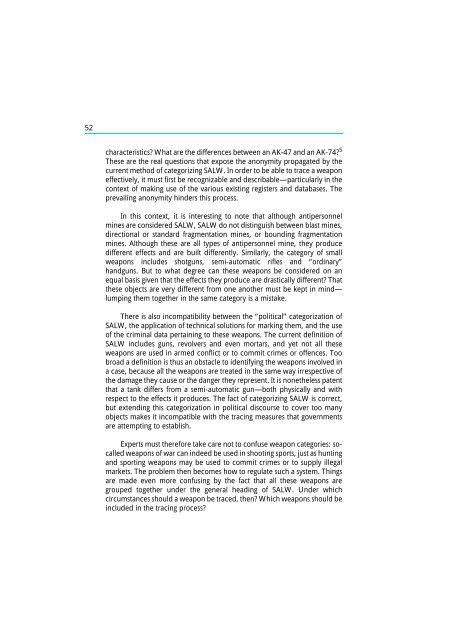The Scope and Implications of a Tracing Mechanism for Small Arms ...
The Scope and Implications of a Tracing Mechanism for Small Arms ...
The Scope and Implications of a Tracing Mechanism for Small Arms ...
You also want an ePaper? Increase the reach of your titles
YUMPU automatically turns print PDFs into web optimized ePapers that Google loves.
52<br />
characteristics? What are the differences between an AK-47 <strong>and</strong> an AK-74? 5<br />
<strong>The</strong>se are the real questions that expose the anonymity propagated by the<br />
current method <strong>of</strong> categorizing SALW. In order to be able to trace a weapon<br />
effectively, it must first be recognizable <strong>and</strong> describable—particularly in the<br />
context <strong>of</strong> making use <strong>of</strong> the various existing registers <strong>and</strong> databases. <strong>The</strong><br />
prevailing anonymity hinders this process.<br />
In this context, it is interesting to note that although antipersonnel<br />
mines are considered SALW, SALW do not distinguish between blast mines,<br />
directional or st<strong>and</strong>ard fragmentation mines, or bounding fragmentation<br />
mines. Although these are all types <strong>of</strong> antipersonnel mine, they produce<br />
different effects <strong>and</strong> are built differently. Similarly, the category <strong>of</strong> small<br />
weapons includes shotguns, semi-automatic rifles <strong>and</strong> “ordinary”<br />
h<strong>and</strong>guns. But to what degree can these weapons be considered on an<br />
equal basis given that the effects they produce are drastically different? That<br />
these objects are very different from one another must be kept in mind—<br />
lumping them together in the same category is a mistake.<br />
<strong>The</strong>re is also incompatibility between the “political” categorization <strong>of</strong><br />
SALW, the application <strong>of</strong> technical solutions <strong>for</strong> marking them, <strong>and</strong> the use<br />
<strong>of</strong> the criminal data pertaining to these weapons. <strong>The</strong> current definition <strong>of</strong><br />
SALW includes guns, revolvers <strong>and</strong> even mortars, <strong>and</strong> yet not all these<br />
weapons are used in armed conflict or to commit crimes or <strong>of</strong>fences. Too<br />
broad a definition is thus an obstacle to identifying the weapons involved in<br />
a case, because all the weapons are treated in the same way irrespective <strong>of</strong><br />
the damage they cause or the danger they represent. It is nonetheless patent<br />
that a tank differs from a semi-automatic gun—both physically <strong>and</strong> with<br />
respect to the effects it produces. <strong>The</strong> fact <strong>of</strong> categorizing SALW is correct,<br />
but extending this categorization in political discourse to cover too many<br />
objects makes it incompatible with the tracing measures that governments<br />
are attempting to establish.<br />
Experts must there<strong>for</strong>e take care not to confuse weapon categories: socalled<br />
weapons <strong>of</strong> war can indeed be used in shooting sports, just as hunting<br />
<strong>and</strong> sporting weapons may be used to commit crimes or to supply illegal<br />
markets. <strong>The</strong> problem then becomes how to regulate such a system. Things<br />
are made even more confusing by the fact that all these weapons are<br />
grouped together under the general heading <strong>of</strong> SALW. Under which<br />
circumstances should a weapon be traced, then? Which weapons should be<br />
included in the tracing process?
















